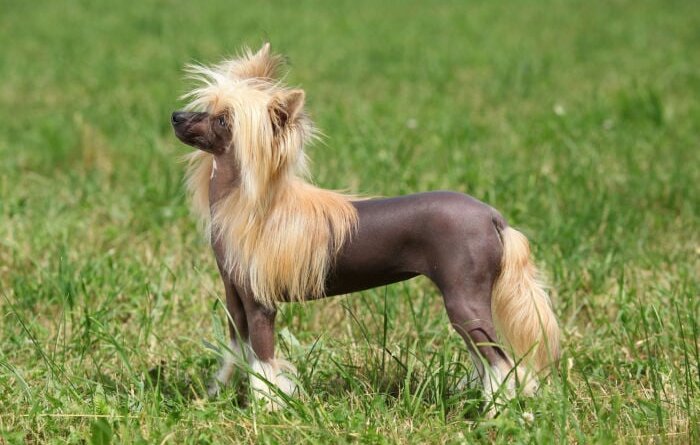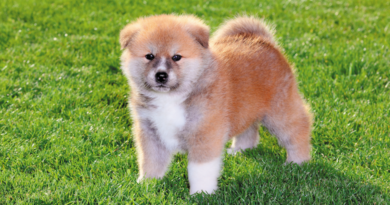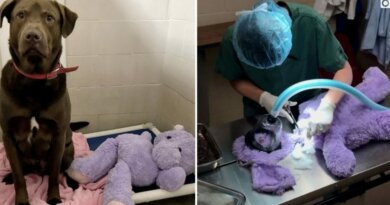Chinese Crested Dog Breed Profile
“What do I need to know before getting a Chinese Crested dog?”
Some curious dog owners might spark the same question in their heads.
And guess what? We found a lot of different—and shocking—answers!
So today, we gathered all the information we could find about this Chinese dog breed.
Read on to learn more about:
- Unique History of the Crested Dogs
- Personality, Health, and Puppy Cost
- 7 Interesting Facts About the Chinese Cresteds
- The Chinese Crested Powderpuff and Hairless Variety
- And so much more!
And without further ado, let’s get right into it.
Chinese Crested Dog Breed Profile
This tiny pooch may swoon your hearts forever, but the Chinese Crested dog has purposeful origins and mighty abilities despite its humble size.
For sure, the Crested dog breed has so much to offer. So, it’s time to get to know and learn what makes them adorable!
Physical Traits of the Chinese Crested Dog
General Appearance
The Chinese Crested dog is a small canine breed that has 2 body types: deer and cobby.
The deer type is small, fine-boned, and slender in body proportion. Meanwhile, the cobby Cresteds appear much heavier in body and bone structure.
Still, Chinese Cresteds are active and athletic regardless of build.
Moreover, Crested dogs have wedge-shaped heads on top or side views with pointed muzzles.
Plus, their almond-shaped eyes and rims add to their elegant look. Their large, erect ears don’t need any cropping whatsoever, too.
Relevant Read: Cropping Dog Ears: Why Is It Done And How It Affects Canines
Height and Weight
Upon maturity, the male Chinese Crested dog stands about 9-13 inches while the females reach 9-11 inches.
Meanwhile, both sexes of this toy breed weigh around 5-12 pounds with proper nutrition and adequate living condition.
Coat and Color
The Chinese Crested dog has 2 coat types: powderpuff and hairless.
Chinese Crested powderpuffs are varieties with long, soft coats. Meanwhile, the hairless type only has hair on its head, feet, and tail.
Moreover, this toy breed’s coat can come in almost all colors. But combinations of blue, lavender, mahogany, white, or black are the most common ones.
Their skin, especially the Chinese Crested hairless type, can be solid, mixed, or spotted with pink or black color.
Living Conditions
Chinese Crested dogs can be great apartment companions — thanks to their cute, petite build.
What’s more, this toy breed makes excellent couch potatoes, too!
When you’re not in the mood for games or walks, it seems like they can read your mind and gladly join you in binge-watching your favorite TV series anytime.
However, the Chinese Crested doggos are known to be athletic and can run incredibly fast.
So, you might need to pet-proof your home to prevent this mighty pooch from escaping and jumping over your window or fence.
Can Chinese Crested Dogs Be Left Alone?
Chinese Crested dogs are extremely social and needy towards their owners. When left for a long time, they may suffer from separation anxiety.
As a result, Cresteds become aggressive dogs and develop bad behaviors, such as barking and, sometimes, destructive habits too.
So, it’s best to have someone pet-sit your Crested dogs at home whenever you’re not around for a long time.
The Chinese Crested Dog Personality
Chinese Crested dogs are friendly, affectionate, and loyal to their companions.
They may tend to get suspicious around strangers at times. But when they fall in love with you, you’ll finally have a mini canine fan tailing you everywhere.
What’s more, your couch potato lifestyle isn’t a big deal for them. They’ll cuddle, snuggle, and spend the entire day curling up on your bed, too.
Moreover, Chinese Crested dogs are agile and active breeds despite their tiny physique.
And when it comes to outdoor walks and activities, they won’t take no for an answer.
Interesting Read: 9 Spring Activities For Dogs
Are Chinese Crested dogs hard to train?
Chinese Crested dogs can be quite difficult to train due to their stubborn nature, especially if they lack exposure to training and socialization at an early age.
They’re oozing intelligence might be overlooked if owners spoil them. Chances are, they’ll develop Small Dog Syndrome.
When this happens, dogs assert their authority over their owners or they perceive themselves as pack leaders at home, which often results in the following:
- Aggression
- Inattentiveness
- Unfriendliness towards other pets
- Stubbornness in following commands
So, take note of this when planning to take a Chinese Crested puppy home.
Are Chinese Crested Dogs Good Pets for Kids?
Chinese Crested dogs are great pets for kids. They’re loving, playful, and affectionate to their companions.
However, be sure to supervise your children around pets and other animals to avoid accidents at home.
The Chinese Crested Health and Care
Care
Chinese Crested dogs aren’t that complicated to handle. But you might ask: “Are Chinese Crested dogs high maintenance?”
In terms of exercise, Chinese Cresteds require minimal physical activities due to their small size.
However, grooming this canine breed involves regular brushes—especially for Powderpuffs—and bathing.
Note: The hairless Chinese Crested variety doesn’t have a strong canine odor.
Interestingly, some of them no longer need sunblock and insect repellents, but it’s still best to seek your vet’s advice on this matter.
Relevant Read: 10 Best De-Shedding Tools for Dogs
Health
Chinese Crested dogs can live healthily throughout their lifetime, but here are some common health problems to be aware of:
Legg-Calve-Perthes Disease
Legg-Calve-Perthes (LCP) disease is the deterioration of the ball of the femur bone, especially in small-breed dogs, which often leads to arthritis.
The cause of LCP in dogs is still unknown. But, studies claim some possible causes, such as:
- Disruption in the blood vessels
- Abnormal blood flow in the femur bone
Moreover, common signs of Legg-Calve-Perthes disease in dogs include:
- Limping
- Leg or joint pain
- Difficulty in moving
Note: Dogs with LCP often lose muscle mass in the affected leg due to non-movement for longer periods.
Treatments for Legg-Calve-Perthes disease in dogs include the following:
- Surgery
- Therapy
- Pain medication
Dental Issues
Chinese Crested dogs are prone to dental issues due to their genetically missing teeth.
These tiny fluffballs develop their peg-like teeth in an outward direction, which causes problems and eating difficulty at times.
And without cure and prevention, tissue damage can occur around the gums that can lead to the following:
- Gingivitis
- Periodontitis
- Unerupted teeth
- Enamel defects
- Endodontic disease
However, this phenomenon is more common in the hairless variety than the powderpuffs.
That said, hairless Crested dogs usually lose their teeth even at a tender age.
Note: Some hairless varieties may require canned food consumption than kibbles.
Still, it’s best to seek your vet’s help regarding this matter.
Progressive Retinal Atrophy
Progressive Retinal Atrophy (PRA) is one of the main culprits of blindness in dogs, according to a study.
Common in small dog breeds, PRA is classified as a genetically transmitted disease in canines that targets the retina of the eyes.
For your reference, some early signs of Progressive Retinal Atrophy in dogs include:
- Total blindness
- Night blindness
- Bright eye-shine
- Cataract formation
Unfortunately, cure and preventive efforts against PRA aren’t widely available and feasible yet.
But, experts are looking into gene therapy as a remedy for both animals and humans.
Dry Eye Syndrome
Dry Eye Syndrome is a common canine eye disease that’s characterized by a deficiency in the water content in the tear duct film.
Several causes of this syndrome include the following:
- Allergies
- Diseases
- Medications
- Birth defects
- Neurological conditions
Moreover, here are some common signs of Dry Eye Syndrome in dogs:
- Red eyes
- Mucus discharge
- Involuntary eye blinking
For a proper and accurate diagnosis, you can do a Schirmer tear test on your Cresteds as this syndrome is often confused with conjunctivitis.
Fortunately, treatments like eye lubricants, antibiotics, and other tear-stimulator drugs are available for Dry Eye Syndrome in dogs.
Chinese Crested Dog Life Span
The Chinese Crested dog’s life expectancy ranges between 10-14 years, given that proper care is provided, such as:
- Diet
- Training
- Exercise
- Socialization and training
- Appropriate living condition
Are Chinese Crested Dogs Rare?
Chinese Crested dogs are a rare canine breed, especially the hairless variety.
This toy breed’s origins are unclear, and its arrival in North America is undocumented, which makes them so interesting.
Also, the Chinese Cresteds have a unique and mighty history, which we’ll discuss in the next section.
Brief History of the Chinese Crested Dog
A lot of arguments have been circulating in the canine community as to the origins of the Chinese Crested dog.
Some say they originally came from East Africa before they were shipped to Asia and the Americas.
But one thing is for sure, Chinese Crested dogs were dedicated rat catchers while aboard Chinese ships.
Because of their petite build, Cresteds can lurk into the deepest and narrowest parts of the ship, chasing and catching pests.
However, this toy breed is one of the rarest in the world.
Interestingly, the Crested’s worldwide popularity rose in the 1950s and was mainly credited to American entertainer, Gypsy Rose Lee.
Lee was an active breeder, and most of the Chinese Cresteds today can be traced from her dog’s lineage.
7 Interesting Facts About The Chinese Crested Dog
1. They Helped Prevent the Spread of the Black Death in Europe
In the mid-1300s, the bubonic plague, known as the Black Death, killed almost one-third of the European population.
Black Death was caused by bacterial infections transmitted by rodents and fleas that spread quickly across Europe.
This also infected some parts of Euroasia due to sea traveling and vessel trading at the time.
Interestingly, the Chinese Crested dogs helped prevent the spread of the disease by catching rats while on board.
Thanks to their hairless nature, Crested dogs can’t also be easily infested with fleas.
Thus, putting a halt to further infections and spreading across the globe.
Trivia: This bacterial infection still exists today but is already treatable with antibiotics.
Relevant Read: Hairless Dogs
2. Powderpuffs and Hairless Cresteds Are Born in A Single Litter
To clarify the confusion in the canine community, both the powderpuff and hairless varieties are of the same breed.
In fact, they’re born together in a single litter.
But you might ask: “Why are both Chinese Crested varieties come in a single birth?”
That’s because of their genetic variation.
Interestingly, the hairless Crested dog inherits this trait from either parent, while the powderpuff variety takes from both at the same time.
And for this reason, it’s possible for both the naked and hairy Crested types to be born in a single litter.
What’s more, both types exude the same personalities and qualities. So, it’s up to your preference which one captures your heart.
3. The Hairless Type is Actually Quite Hairy
Contrary to popular belief, the hairless Crested dog actually sheds a lot.
Many hairless varieties have more body hair than you can expect from them.
That said, Crested dogs aren’t totally hypoallergenic, especially for owners with little to no tolerance.
You may even notice some strands of hair on their head, body, legs, and tail too.
Note: Owners must shave the hairless Crested dog’s body to keep its skin healthy.
The truth is, long fur in hairless varieties can’t keep them warm in cold weather. They’ll only be prone to skin problems as a result.
Interesting Read: Non-Shedding Dog Breeds (Ranking The Dogs That Don’t Shed)
4. They’re Unbelievably Heat-Tolerant
Yes, you read that right.
Chinese Crested dogs can sunbathe in 100-degree heat for several hours without heavy panting at all.
Plus, they don’t even drink as much water as other breeds do, which might worry new dog owners out there.
What’s more, Chinese Crested dogs don’t sweat through their skin.
Note: Crested dogs can’t thrive in cold weather.
So, be sure to equip your Crested pooch and let them wear dog sweaters for the winter seasons.
5. They Need No Insect Repellents
Owning a Chinese Crested dog is like living with a slightly different creature — they’re an unconventional dog breed!
While most canine breeds rely on skin treatments, Cresteds don’t actually need them.
That said, it’s recommended to take a cautious approach in administering treatments, such as:
- Vaccinations
- Cortisone drugs
- Topical medicines
Furthermore, Chinese Crested dogs are prone to skin allergies and infections — though these are sometimes caused by skin products.
Important: Consult your vet regarding rabies vaccination for your Crested dogs. They sometimes suffer from reactions after getting their shot.
Relevant Read: How Many Shots Do Puppies Need?
6. They’re Prone to Separation Anxiety
Like most dog breeds, Chinese Cresteds can become extremely needy that it’s difficult for them to cope with your absence.
And when separation anxiety hits, they may develop aggressive behaviors, such as:
- Destructive habits
- Excessive barking
- Escaping tendencies
Tip: You can have someone, particularly a familiar face, dog-sit your Cresteds at home when you’re out for longer periods.
7. They’re A Bit Pricey, Too
Chinese Cresteds are one of the most in-demand toy breeds. But with immense popularity comes great money.
How much are Chinese Crested dogs worth?
On average, Chinese Crested puppies cost around $1,000 to $4,000, especially if they’re from reputable breeders.
However, the hairless variety costs way more than powderpuffs due to its rarity and popularity.
Remember: Adopting is always a great alternative to shopping.
Who knows, you may find a Crested pooch in animal shelters that needs a forever home, right?
Relevant Read: 20 Most Expensive Dog Breeds
Chinese Crested Dog Breed: In A Nutshell
Indeed, there’s more to the Chinese Crested dog than just its prominent feature — hairless or powderpuff.
These types may vary in looks, but they share common qualities that you’ll definitely love.
The Chinese Crested Powderpuff dog takes its fur trait from both parents.
Meanwhile, either one of their parent’s genes is vital for the Chinese Crested Hairless variety to be called such.
Personality-wise, Cresteds are affectionate, loyal, and energetic fluffballs all wrapped into one petite build.
They can spend an entire lazy day with you or show off their athletic skills, too.
When it comes to owning one, it’s important to know that Chinese Crested dogs are more skin-sensitive than most breeds.
And despite their miniature size, Chinese Crested puppies cost a fortune, especially from reputable dog breeders.
Regardless of type, powderpuffs and hairless Cresteds can capture your hearts forever with their loyalty and love.
READ NEXT: Chihuahua Dog Breed Profile
The post Chinese Crested Dog Breed Profile appeared first on Top Dog Tips.







